Synthesis of Core–Shell Micro/Nanoparticles and Their Tribological Application: A Review
Abstract
1. Introduction
2. Synthesis of Core–Shell Micro/Nanoparticles
2.1. Solid Phase Reaction
2.2. Liquid Phased Reaction
2.3. Gas Phase Reaction
2.4. Mechanical Mixing
3. Applications
3.1. Fillers in Solid Lubricant Matrix
3.1.1. Enhanced Mechanical Properties
3.1.2. Enhanced Tribological Properties
3.2. Additives in Liquid Lubricants
3.3. Composite Abrasives in Chemical Mechanical Polishing
- The abrasives must be neither harder than the substrate to cause severe mechanical damage nor too soft to remove the chemically generated surface.
- The abrasives do not react with the composition of the polishing fluid.
- The abrasives must be well dispersed in the polishing fluid and not agglomerate.
- The abrasives do not dissolve in the polishing fluid.
3.4. Basic Units in Bulk Composites
4. Conclusions
Author Contributions
Funding
Conflicts of Interest
References
- Chen, S.; Zhou, Y.; Luo, H.; Tang, L.; Guo, R.; Zhang, D. Core-shell TiO2HfO2 nanowire arrays with designable shell thicknesses for improved permittivity and energy density in polymer nanocomposites. Compos. Part A Appl. Sci. Manuf. 2020, 137, 106012. [Google Scholar] [CrossRef]
- Zhu, X.T.; Yang, J.; Dastan, D.; Garmestani, H.; Fan, R.H.; Shi, Z.C. Fabrication of core-shell structured Ni@BaTiO3 scaffolds for polymer composites with ultrahigh dielectric constant and low loss. Compos. Part A Appl. Sci. Manuf. 2019, 125, 105521. [Google Scholar] [CrossRef]
- Zhang, Y.; Yang, Z.J.; Pan, T.; Gao, H.; Guan, H.T.; Xu, J.Z.; Zhang, Z. Construction of natural fiber/polyaniline core-shell heterostructures with tunable and excellent electromagnetic shielding capability via a facile secondary doping strategy. Compos. Part A Appl. Sci. Manuf. 2020, 137, 105994. [Google Scholar] [CrossRef]
- Lin, C.M.; Zeng, C.C.; Wen, Y.S.; Gong, F.Y.; He, G.S.; Li, Y.B.; Yang, Z.; Ding, L.; Li, J.; Guo, S. Litchi-like core-shell HMX@HPW@PDA microparticles for polymer bonded energetic composites with low sensitivity and high mechanical properties. ACS Appl. Mater. Interfaces 2020, 12, 4002–4013. [Google Scholar] [CrossRef] [PubMed]
- Lin, C.M.; Huang, B.; Gong, F.Y.; Yang, Z.J.; Liu, J.H.; Zhang, J.H.; Zeng, C.; Li, Y.; Li, J.; Guo, S. Core@double-shell structured energetic composites with reduced sensitivity and enhanced mechanical properties. ACS Appl. Mater. Interfaces 2019, 11, 30341–30351. [Google Scholar] [CrossRef]
- Su, H.Y.; Tian, Q.; Cameron-Alexander, H.P.; Xu, L.; Qian, K.; Liu, J. Nanoporous core@shell particles: Design, preparation, application in bioadsorption and biocatalysis. Nano Today 2020, 100834. [Google Scholar] [CrossRef]
- Khalida, N.; Zahoor, H.F.; Robina, B.; Weitai, W.; Ahmad, I.; Muhammad, A. Systematic study of catalytic degradation of nitrobenzene derivatives using core@shell composite micro particles as catalyst. Colloids Surf. A Physicochem. Eng. Asp. 2020, 594, 124646. [Google Scholar]
- Ibrahim, A.E.; Hashem, H.; Elhenawee, M.; Saleh, H. Monolithic and core-shell particles stationary phase morphologies in protein analysis; peptide mapping of erythropoietin hormone and determination of carbetocin. Ann. Pharm. Fr. 2020, 78, 206–216. [Google Scholar] [CrossRef]
- Han, C.J.; Gu, H.Z.; Zhang, M.J.; Huang, A.; Zhang, Y.; Wang, Y. Thermal properties of Al-Si/Al2O3 core-shell particles prepared by using steam hydration method. J. Alloy. Compd. 2020, 817, 152801. [Google Scholar] [CrossRef]
- Lu, G.L.; Liu, F.H.; Chen, X.; Yang, J.F. Cu nanowire wrapped and Cu3Si anchored Si@Cu quasi core-shell composite microsized particles as anode materials for Li-ion batteries. J. Alloy. Compd. 2019, 809, 151750. [Google Scholar] [CrossRef]
- De Greef, T.F.A.; Meijer, E.W. Supramolecular polymers. Nature 2008, 453, 171–173. [Google Scholar] [CrossRef] [PubMed]
- Yamamoto, T.; Uematsu, K.; Irisawa, T.; Tanabe, Y. A polymer colloidal technique for enhancing bending properties of carbon fiber-reinforced thermoplastics using nylon modifier. Compos. Part A Appl. Sci. Manuf. 2018, 112, 250–254. [Google Scholar] [CrossRef]
- Eyckens, D.; Randall, J.D.; Stojcevski, F.; Sarlin, E.; Palola, S.; Kakkonen, M.; Scheffler, C.; Henderson, L.C. Examining interfacial interactions in a range of polymers using poly(ethylene oxide) functionalized carbon fibers. Compos. Part A Appl. Sci. Manuf. 2020, 138, 106053. [Google Scholar] [CrossRef]
- Wang, Y.X.; Bhushan, B. Wear-resistant and antismudge superoleophobic coating on polyethylene terephthalate substrate using SiO2 nanoparticles. ACS Appl. Mater. Interfaces 2015, 7, 743. [Google Scholar] [CrossRef]
- Li, B.; Wang, X.; Liu, W.; Xue, Q. Tribochemistry and antiwear mechanism of organic-inorganic nanoparticles as lubricant additives. Tribol. Lett. 2006, 22, 79. [Google Scholar] [CrossRef]
- Zhang, L.; Wang, H.B.; Zhang, Z.F.; Qin, F.; Liu, W.L.; Song, Z.T. Preparation of monodisperse polystyrene/silica core-shell nano-composite abrasive with controllable size and its chemical mechanical polishing performance on copper. Appl. Surf. Sci. 2011, 258, 1217–1224. [Google Scholar] [CrossRef]
- Bian, B.R.; He, J.H.; Du, J.; Xia, W.X.; Zhang, J.; Liu, J.P.; Li, W.; Hu, C.; Yan, A. Growth mechanism and magnetic properties of monodisperse L10-Co(Fe)Pt@C core-shell nanoparticles by one step solid-phase synthesis. Nanoscale 2015, 7, 975–980. [Google Scholar] [CrossRef]
- Nalluri, S.R.; Nagarjuna, R.; Patra, D.; Ganesan, R.; Gopalan, B. Large scale solid-state synthesis of catalytically active Fe3O4@M(M=Au, Ag and Au-Ag alloy) core-shell nanostructures. Nature 2019, 9, 6603. [Google Scholar] [CrossRef]
- Chaudhuri, T.K.; Tiwari, D. Earth-abundant non-toxic Cu2ZnSnS4 thin films by direct liquid coating from metal-thiourea precursor solution. Sol. Energy Mater. Sol. Cells 2012, 101, 46–50. [Google Scholar] [CrossRef]
- Wang, Y.J.; Xiong, Y.; Chen, F.; Luo, G.S. Preparation of core-shell glass bead/polysulfone microspheres with two-step sol-gel process. J. Appl. Polym. Sci. 2006, 99, 3365–3369. [Google Scholar]
- Marini, M.; Toselli, M.; Borsacchi, S.; Mollica, G.; Geppi, M.; Pilati, F. Facile synthesis of core-shell organic-inorganic hybrid nanoparticles with amphiphilic polymer shell by one-step sol-gel reactions. J. Polym. Sci. Part A Pol. Chem. 2008, 46, 1699–1709. [Google Scholar] [CrossRef]
- Eckardt, O.; Pietsch, C.; Zumann, O.; Moritz, V.L.; Brauer, D.S.; Schacher, F.H. Well-defined SiO2@P(EtOx-stat-EI) core-shell hybrid nanoparticles via sol-gel process. Macromol. Rapid Commun. 2015, 37, 337–342. [Google Scholar] [CrossRef] [PubMed]
- Sun, L.B.; Shi, Y.C.; Chu, L.Y.; Wang, Y.; Zhang, L.Y.; Liu, J.R. Preparation and characterization of silica/polypyrrole core-shell colloidal particles in the presence of ethanol as the cosolvent. J. Appl. Polym. Sci. 2011, 123, 3270–3274. [Google Scholar] [CrossRef]
- Antonioli, D.; Deregibus, S.; Panzarasa, G.; Sparnacci, K.; Laus, M.; Boarino, L.; Enrico, E.; Comoretto, D. PTFE-PMMA core-shell colloidal particles as building blocks for self-assembled opals: Synthesis, properties and optical response. Polym. Int. 2012, 61, 1294–1301. [Google Scholar] [CrossRef]
- Poovarodom, S.; Bass, J.D.; Hwang, S.J.; Katz, A. Investigation of the core-shell interface in gold@silica nanoparticles: A silica imprinting approach. Langmuir 2005, 21, 12348–12356. [Google Scholar] [CrossRef]
- Ung, T.; Liz-Marzan, L.M.; Mulvaney, P. Controlled method for silica coating of silver colloids influence of coating on the rate of chemical reactions. Langmuir 1998, 14, 3740–3748. [Google Scholar] [CrossRef]
- Jing, Z.; Xia, T.; Yuan, P.; Zeng, X.F.; Chen, J. Core/shell structured ZnO/SiO2 nanoparticles: Preparation, characterization and photocatalytic property. Appl. Surf. Sci. 2010, 257, 393–397. [Google Scholar]
- Rogach, A.L.; Nagesha, D.; Ostrander, J.W.; Michael, G.; Kotov, N. “Raisin Bun”-type composite spheres of silica and semiconductor nanocrystals. Chem. Mater. 2000, 12, 2676–2685. [Google Scholar] [CrossRef]
- Sun, J.; Zhuang, J.Q.; Guan, S.W.; Yang, W.S. Synthesis of robust water-soluble ZnS: Mn/SiO2 core/shell nanoparticles. J. Nanoparticle Res. 2008, 10, 653–658. [Google Scholar] [CrossRef]
- Kumar, S.; Zou, S.Z. Electrooxidation of carbon monoxide and methanol on platinum-overlayer-coated gold nanoparticles: Effects of film thickness. Langmuir 2007, 23, 7365–7371. [Google Scholar] [CrossRef]
- Zhang, S.X.; Niu, H.Y.; Hu, Z.J.; Cai, Y.Q.; Shi, Y.L. Preparation of carbon coated Fe3O4 nanoparticles and their applications for solid-phase extraction of polycyclic aromatic hydrocarbons from environmental water samples. J. Chromatogr. A 2010, 1217, 4757–4764. [Google Scholar] [CrossRef] [PubMed]
- Ovari, L.; Berko, A.; Balazs, N.; Majzik, Z.; Kiss, J. Formation of Rh-Au core-shell nanoparticles on TiO2(110) surface studied by STM and LEIS. Langmuir 2010, 26, 2167–2175. [Google Scholar] [CrossRef] [PubMed]
- Berko, A.; Klivenyi, G.; Solymosi, F. Fabrication of Ir/TiO2(110) planar catalysts with tailored particle size and distribution. J. Catal. 1999, 182, 511–514. [Google Scholar] [CrossRef]
- Langlois, C.; Benzo, P.; Arenal, R.; Benoit, M.; Nicolai, J.; Combe, N.; Ponchet, A.; Casanove, M.J. Fully crystalline faceted Fe-Au core-shell nanoparticles. Nano Lett. 2015, 15, 5075–5080. [Google Scholar] [CrossRef] [PubMed]
- Mero, O.; Sougrati, M.T.; Jumas, J.C.; Margel, S. Engineered magnetic core-shell SiO2/Fe microspheres and “Medusa-like” microspheres of SiO2/iron oxide/carbon nanofibers or nanotubes. Langmuir 2014, 30, 9850–9858. [Google Scholar] [CrossRef]
- Nan, C.Y.; Lin, Z.; Liao, H.G.; Song, M.K.; Li, Y.D.; Cairns, E.J. Durable carbon-coated Li2S core-shell spheres for high performance lithium/sulfur cells. J. Am. Chem. Soc. 2014, 136, 4659–4663. [Google Scholar] [CrossRef]
- Cao, L.Z.; Jiang, H.; Song, H.; Li, Z.M.; Miao, G.Q. Thermal CVD synthesis and photoluminescence of SiC/SiO2 core-shell structure nanoparticles. J. Alloy. Compd. 2010, 489, 562–565. [Google Scholar] [CrossRef]
- Cui, P.; Li, F.S.; Yang, Y.; Jiang, W.; Liu, H.Y. Design of typical device for powder surface modification of micron and nano-sized powder by mechano-mixed method. China Powder Sci. Technol. 2006, 1, 17–19. (In Chinese) [Google Scholar]
- Heidarpour, A.; Karimzadeh, F.; Enayati, M.H. In situ synthesis mechanism of Al2O3-Mo nanocomposite by ball milling process. J. Alloy. Compd. 2009, 477, 692–695. [Google Scholar] [CrossRef]
- He, W.; Lv, Y.Q.; Zhao, Y.P.; Xu, C.R.; Jin, Z.; Chao, Q.; Yin, L. Core-shell structured gel-nanocarriers for sustained drug release and enhanced antitumor effect. Int. J. Pharm. 2015, 484, 163–171. [Google Scholar] [CrossRef]
- Tang, G.G.; Zhang, J.; Liu, C.C.; Zhang, D.; Wang, Y.Q.; Tang, H.; Li, C. Synthesis and tribological properties of flower-like MoS2 microspheres. Ceram. Int. 2014, 40, 11575–11580. [Google Scholar] [CrossRef]
- Zheng, H.Z.; Zhang, J.; Lu, S.Q.; Wang, G.C.; Xu, Z.F. Effect of core-shell composite particles on the sintering behavior and properties of nano-Al2O3/polystyrene composite prepared by SLS. Mater. Lett. 2006, 60, 1219–1223. [Google Scholar] [CrossRef]
- Wei, Y.X.; Deng, C.; Chen, H.; Wan, L.; Wei, W.C.; Wang, Y.Z. Novel core-shell hybrid nanosphere towards the mechanical enhancement and fire retardance of polycarbonate. ACS Appl. Mater. Interfaces 2018, 10, 28036–28050. [Google Scholar] [CrossRef] [PubMed]
- Mekuria, T.D.; Zhang, C.H.; Fouad, D.E.; Fouad, D.E. The effect of thermally developed SiC@SiO2 core-shell structured nanoparticles on the mechanical, thermal and UV-shielding properties of polyimide composites. Compos. Part B Eng. 2019, 173, 106917. [Google Scholar] [CrossRef]
- Zhu, A.P.; Shi, Z.H.; Cai, A.Y.; Zhao, F.; Liao, T.Q. Synthesis of core-shell PMMA-SiO2 nanoparticles with suspension-dispersion-polymerization in an aqueous system and its effect on mechanical properties pf PVC composites. Polym. Test. 2008, 27, 540–547. [Google Scholar] [CrossRef]
- Yao, D.D.; Zhang, Z.L.; Zheng, Y.P.; Wang, Y.D.; Wang, D.C. Enhanced mechanical property of polyacrylic acid composite hydrogel by the synergistic role of core-shell structured SiO2@PDMAEMA nano-objects. Compos. Sci. Technol. 2019, 181, 107711. [Google Scholar] [CrossRef]
- Chatterjee, A.; Mishra, S. Rheological thermal and mechanical properties of nano-calcium carbonate (CaCO3)/poly(methyl methacrylate) (PMMA) core-shell nanoparticles reinforced polypropylene (PP) composites. Macromol. Res. 2013, 21, 474–483. [Google Scholar] [CrossRef]
- Chatterjee, A.; Mishra, S. Nano-calcium carbonate (CaCO3)/polystyrene (PS) core-shell nanoparticles: It’s effect on physical and mechanical properties of high impact polystyrene (HIPS). J. Polym. Res. 2013, 20, 249. [Google Scholar] [CrossRef]
- Navinchandra, G.S.; Mahesh, B.; Satyendra, M. TiO2/polystyrene core-shell nanoparticles as fillers for LLDPE/PLA blend: Development, and morphological, thermal and mechanical properties. Polym. Bull. 2016, 73, 3049–3063. [Google Scholar]
- Liu, L.; Wang, Y.; Hu, Q.G.; Li, T.; Ma, P.M.; Zhang, H.J.; Chen, M.; Dong, W. Core-shell starch nanoparticles improve the mechanical and thermal properties of poly(propylene carbonate). ACS Sustain. Chem. Eng. 2019, 7, 13081–13088. [Google Scholar] [CrossRef]
- Nooma, S.; Magaraphan, R. Core-shell natural rubber and its effect on toughening and mechanical properties of poly(methyl methacrylate). Polym. Bull. 2019, 76, 3329–3354. [Google Scholar] [CrossRef]
- Misuk, C.; Young, I.O.; Jae, D.N.; Lee, Y.K. Influence of elastomeric core-shell impact modifiers on mechanical properties of cellulose diacetate resin. Cellulose 2013, 20, 3239–3245. [Google Scholar]
- Fu, N.; Yang, Y.Y.; Ma, J.; Yu, X.Y.; Ding, H.L.; Qu, X.W. Preparation of core-shell structured polyacrylic modifiers and effects of the core-shell weight ratio on toughening of poly(butylene terephthalate). Chin. J. Polym. Sci. 2015, 33, 291–300. [Google Scholar] [CrossRef]
- Wang, H.Y.; Lei, Y.; Liu, D.J.; Wang, C.; Zhu, Y.J.; Zhu, J.H. Investigation of the tribological properties: Core-shell structured magnetic Ni@NiO nanoparticles reinforced epoxy nanocomposites. Tribol. Int. 2015, 83, 139–145. [Google Scholar] [CrossRef]
- Yang, H.J.; Mo, Q.F.; Li, W.Z.; Gu, F.M. Preparation and properties of self-healing and self-lubricating epoxy coatings with polyurethane microcapsules containing bifunctional linseed oil. Polymers 2019, 11, 1578. [Google Scholar] [CrossRef]
- Yang, Z.R.; Guo, Z.W.; Yuan, C.Q. Tribological behavior of polymer composites functionalized with various microcapsule core materials. Wear 2019, 426, 853–861. [Google Scholar] [CrossRef]
- Li, H.Y.; Cui, Y.X.; Wang, H.Y.; Zhu, Y.J.; Wang, B.H. Preparation and application of polysulfone microcapsules containing tung oil in self-healing and self-lubricating epoxy coating. Colloids Surf. A Physicochem. Eng. Asp. 2017, 518, 181–187. [Google Scholar] [CrossRef]
- Li, H.Y.; Cui, Y.X.; Li, Z.K.; Zhu, Y.J.; Wang, H.Y. Fabrication of microcapsules containing dual-functional tung oil and properties suitable for self-healing and self-lubricating coatings. Prog. Org. Coat. 2018, 115, 164–171. [Google Scholar] [CrossRef]
- Li, H.Y.; Li, S.; Li, F.B.; Li, Z.K.; Wang, H.Y. Fabrication of SiO2 wrapped polystyrene microcapsules by pickering polymerization for self-lubricating coatings. J. Colloid Interface Sci. 2018, 528, 92–99. [Google Scholar] [CrossRef]
- Ma, Y.J.; Li, Z.K.; Wang, H.Y.; Li, H. Synthesis and optimization of polyurethane microcapsules containing [BMIM]PF6 ionic liquid lubricant. J. Colloid. Interface Sci. 2019, 534, 469–479. [Google Scholar] [CrossRef]
- Imani, A.; Zhang, H.; Owais, M.; Zhao, J.; Chu, P.F.; Yang, J.L.; Zhang, Z. Wear and friction of epoxy based nanocomposites with silica nanoparticles and wax-containing microcapsules. Compos. Part A Appl. Sci. Manuf. 2018, 107, 607–615. [Google Scholar] [CrossRef]
- Yang, Z.R.; Guo, Z.W.; Yuan, C.Q. Effects of MoS2 microcapsulation on the tribological properties of a composite material in a water-lubricant condition. Wear 2019, 432, 102919. [Google Scholar] [CrossRef]
- Chen, B.B.; Jia, Y.H.; Zhang, M.J.; Liang, H.Y.; Li, X.; Yang, J.; Yan, F.; Li, C. Tribological properties of epoxy lubricating composite coatings reinforced with core-shell structure of CNF/MoS2 hybrid. Compos. Part A Appl. Sci. Manuf. 2019, 122, 85–95. [Google Scholar] [CrossRef]
- Wu, G.Y.; Xu, C.H.; Xiao, G.C.; Yi, M.D.; Chen, Z.Q.; Chen, H. An advanced self-lubricating ceramic composite with the addition of core-shell structured h-BN@Ni powders. Int. J. Refract. Met. Hard Mater. 2018, 72, 276–285. [Google Scholar] [CrossRef]
- Fan, C.L.; Li, H.L.; Jin, L.; Zhang, M.J.; Xiao, L.H.; Li, M.; Ao, Y. Improving tribological properties of phenolic resin/carbon fiber composites using m-Si3N4@PANI core-shell particles. J. Appl. Polym. Sci. 2019, 136, 47785. [Google Scholar] [CrossRef]
- Lian, W.Q.; Mai, Y.J.; Wang, J.; Zhang, L.Y.; Liu, C.S.; Jie, X.H. Fabrication of graphene oxide-Ti3AlC2 synergistically reinforced copper matrix composites with enhanced tribological performance. Ceram. Int. 2019, 45, 18592–18598. [Google Scholar] [CrossRef]
- Zhang, J.S.; Yang, S.F.; Chen, Z.X.; Wyszomirska, M.; Zhao, J.W.; Jiang, Z.Y. Microstructure and tribological behavior of alumina composites reinforced with SiC-graphene core-shell nanoparticles. Tribol. Int. 2019, 131, 94–101. [Google Scholar] [CrossRef]
- Yoo, S.C.; Kang, B.; Van Trinh, P.; Doan, D.P.; Soon, H.H. Enhanced mechanical and wear properties of Al6061 alloy nanocomposite reinforced by CNT-template-grown core-shell CNT/SiC nanotubes. Sci. Rep. 2020, 10, 12896. [Google Scholar] [CrossRef]
- Ali, I.; Basheer, A.A.; Kucherova, A.; Memetov, N.; Pasko, T.; Ovchinnikov, K.; Pershin, V.; Kuznetsov, D.; Galunin, E.; Grachev, V.A.; et al. Advances in carbon nanomaterials as lubricants modifiers. J. Mol. Liq. 2019, 251–266. [Google Scholar] [CrossRef]
- Tang, J.Z.; Chen, S.Q.; Jia, Y.L.; Ma, Y.; Xie, H.M.; Quan, X.; Ding, Q. Carbon dots as an additive for improving performance in water-based lubricants for amorphous carbon (a-C) coatings. Carbon 2020, 156, 272–281. [Google Scholar] [CrossRef]
- Luo, N.; Xiang, J.X.; Shen, T.; Liang, H.L.; Xin, S. One-step gas-liquid detonation synthesis of carbon nano-onions and their tribological performance as lubricant additives. Diam. Relat. Mater. 2019, 97, 107448. [Google Scholar] [CrossRef]
- Lee, G.J.; Park, J.J.; Lee, M.K.; Rhee, C.K. Stable dispersion of nanodiamonds in oil and their tribological properties as lubricant additives. Appl. Surf. Sci. 2017, 415, 24–27. [Google Scholar] [CrossRef]
- Sanes, J.; Aviles, M.D.; Saurin, N.; Espinosa, T.; Carrion, F.J.; Bermudez, M.D. Synergy between graphene and ionic liquid lubricant additives. Tribol. Int. 2017, 116, 371–382. [Google Scholar] [CrossRef]
- Li, S.; Bhushan, B. Lubrication performance and mechanism of Mg/Al-, Zn/Al-, and Zn/Mg/Al-layered double hydroxide nanoparticles as lubricant additives. Appl. Surf. Sci. 2016, 378, 308–319. [Google Scholar] [CrossRef]
- Wang, L.; Gong, P.W.; Li, W.; Luo, T.; Cao, B.Q. Mono-dispersed Ag/Graphene nanoparticles as lubricant additive to reduce friction and wear. Tribol. Int. 2020, 146, 106228. [Google Scholar] [CrossRef]
- Wu, H.; Zhao, J.W.; Xia, W.Z.; Cheng, X.W.; He, A.S.; Yun, J.H.; Wang, L.; Huang, H.; Jiao, S.; Huang, L.; et al. Analysis of TiO2 nano-additive water-based lubricants in hot rolling of microalloyed steel. J. Manuf. Process. 2017, 27, 26–36. [Google Scholar] [CrossRef]
- Dayana, I.; Sembiring, T.; Tetuko, A.P.; Sembiring, K.; Maulida, N.; Cahyarani, Z.; Setiadi, E.A.; Asri, N.S.; Ginting, M.; Sebayang, P. The effect of tetraethyl orthosilicate (TEOS) additions as silica precursors on the magnetite nano-particles (Fe3O4) properties for the application of ferro-lubricant. J. Mol. Liq. 2019, 294, 111557. [Google Scholar] [CrossRef]
- Saidi, M.Z.; Pasc, A.; El Moujahid, C.; Canilho, N.; Badawi, M.; Delgado-Sanchez, C.; Celzard, A.; Fierro, V.; Peignier, R.; Kouitat-Njiwa, R.; et al. Improved tribological properties, thermal and colloidal stability of poly-α-olefins based lubricants with hydrophobic MoS2 submicron additives. J. Colloid Interface Sci. 2020, 562, 91–101. [Google Scholar] [CrossRef]
- Charoo, M.S.; Wani, M.F.; Hanief, M.; Rather, M.A. Tribological properties of MoS2 particles as lubricant additives on EN31 alloy steel and AISI 52100 steel ball. Mater. Today Proc. 2017, 4, 9967–9971. [Google Scholar] [CrossRef]
- Gu, Y.F.; Fei, J.; Huang, J.F.; Zhang, L.J.; Qu, M. Synthesis and tribological performance of carbon microspheres/poly(methyl methacrylate) core-shell particles as highly efficient lubricant. J. Phys. Chem. C 2019, 123, 29037–29046. [Google Scholar] [CrossRef]
- Frank, T.H.; Schneider, A.; Sarathy, S.M. Enhanced lubrication by core-shell TiO2 nanoparticles modified with gallic acid ester. Tribol. Int. 2020, 146, 106263. [Google Scholar]
- Chen, L.; Xu, H.Y.; Cui, H.X.; Zhou, H.D.; Wan, H.Q.; Chen, J.M. Preparation of Cu-Ni bimetallic nanoparticles surface-capped with dodecanethiol and their tribological properties as lubricant additive. Particuology 2017, 89–96. [Google Scholar] [CrossRef]
- Huang, J.; Li, Y.; Jia, X.H.; Song, H.J. Preparation and tribological properties of core-shell Fe3O4@C microspheres. Tribol. Int. 2019, 129, 427–435. [Google Scholar] [CrossRef]
- Liu, T.T.; Zhou, C.H.; Gao, C.P.; Zhang, Y.J.; Yang, G.B.; Zhang, P.Y. Preparation of Cu@SiO2 composite nanoparticle and its tribological properties as water-based lubricant additive. Lubr. Sci. 2020, 32, 69–79. [Google Scholar] [CrossRef]
- Jeng, Y.R.; Huang, Y.H.; Tsai, P.C.; Hwang, G.L. Tribological properties of carbon nanocapsule particles as lubricant additive. J. Tribol. 2014, 136, 041801. [Google Scholar] [CrossRef] [PubMed]
- Ren, B.J.; Gao, L.; Xie, B.T.; Li, M.J.; Zhang, S.D.; Zu, G.Q.; Ran, X. Tribological properties and anti-wear mechanism of ZnO@graphene core-shell nanoparticles as lubricant additives. Tribol. Int. 2020, 144, 106114. [Google Scholar] [CrossRef]
- Xu, Y.F.; Geng, J.; Peng, Y.B.; Liu, Z.C.; Yu, J.Y.; Hu, X.G. Lubricating mechanism of Fe3O4@MoS2 core-shell nanocomposites as oil additives for steel/steel contact. Tribol. Int. 2018, 121, 241–251. [Google Scholar] [CrossRef]
- Liu, L.; Jiao, S.L.; Peng, Y.T.; Zhou, W. A green design for lubrication: Multifunctional system containing Fe3O4@MoS2 nanohybrid. ACS Sustain. Chem. Eng. 2018, 6, 7372–7379. [Google Scholar] [CrossRef]
- Liu, G.Q.; Cai, M.R.; Zhou, F.; Liu, W.M. Charged polymer brushes-grafted hollow silica nanoparticles as a novel promising material for simultaneous joint lubrication and treatment. J. Phys. Chem. B 2014, 118, 4920–4931. [Google Scholar] [CrossRef]
- Qi, H.M.; Guo, Y.X.; Zhang, L.G.; Li, G.T.; Zhang, G.; Wang, T.M.; Wang, Q. Covalently attached mesoporous silica-ionic liquid hybrid nanomaterial as water lubrication additives for polymer-metal tribopair. Tribol. Int. 2018, 119, 721–730. [Google Scholar] [CrossRef]
- Beheshit, A.; Huang, Y.; Ohno, K.; Blakey, I.; Stokes, J.R. Improving tribological properties of oil-based lubricants using hybrid colloidal additives. Tribol. Int. 2020, 144, 106130. [Google Scholar] [CrossRef]
- Lee, H.; Lee, D.; Jeong, H. Mechanical aspects of the chemical mechanical polishing process: A review. Int. J. Precis. Eng. Manuf. 2016, 17, 525–536. [Google Scholar] [CrossRef]
- Chen, Y.; Qian, C.; Miao, N.M. Atomic force microscopy indentation to determine mechanical property for polystyrene-silica core-shell hybrid particles with controlled shell thickness. Thin Solid Films 2015, 579, 57–63. [Google Scholar] [CrossRef]
- Chen, A.L.; Mu, W.B.; Chen, Y. Compressive elastic moduli and polishing performance of non-rigid core/shell structured PS/SiO2 composite abrasives evaluated by AFM. Appl. Surf. Sci. 2014, 290, 433–439. [Google Scholar] [CrossRef]
- Chen, Y.; Qin, J.W.; Wang, Y.Y.; Li, Z.F. Core/shell composites with polystyrene cores and meso-silica shells as abrasive for improved chemical mechanical polishing behavior. J. Nanopart. Res. 2015, 17, 363. [Google Scholar] [CrossRef]
- Chen, A.L.; Wang, Y.Y.; Qin, J.W.; Li, Z.F. Chemical mechanical polishing for SiO2 film using polystyrene@ceria (PS@CeO2) core-shell nanocomposites. J. Inorg. Organomet. Polym. Mater. 2015, 25, 1407–1413. [Google Scholar] [CrossRef]
- Chen, Y.; Long, R.W. Polishing behavior of PS/CeO2 hybrid microspheres with controlled shell thickness on silicon dioxide CMP. Appl. Surf. Sci. 2011, 257, 8679–8685. [Google Scholar] [CrossRef]
- Chen, A.L.; Long, J.L.; Li, Z.N.; Chen, Y. Copper chemical mechanical polishing performance of polystyrene ceria hybrid abrasives with a core/shell structure. J. Inorg. Organomet. Polym. Mater. 2018, 28, 1655–1663. [Google Scholar] [CrossRef]
- Armini, S.; Whelan, C.M.; Maex, K. Engineering polymer core-silica shell size in the composite abrasives for CMP applications. Electrochem. Solid State Lett. 2008, 11, 280–284. [Google Scholar] [CrossRef]
- Basim, G.B.; Alder, J.J.; Mahajan, U.; Singh, R.K.; Moudgil, B.M. Effect of particle size of chemical mechanical polishing slurries for enhanced polishing with minimal defects. J. Electrochem. Soc. 2000, 147, 3523–3528. [Google Scholar] [CrossRef]
- Sui, G.; Zhong, W.H.; Ren, X.; Wang, X.Q.; Yang, X.P. Structure, mechanical properties and friction behavior of UHMWPE/HDPE/carbon nanofibers. Mater. Chem. Phys. 2009, 115, 404–412. [Google Scholar] [CrossRef]
- Vail, J.R.; Burris, D.L.; Sawyer, W.G. Multifunctionality of single-walled carbon nanotube-polytetrafluoroethylene nanocomposites. Wear 2009, 267, 619–624. [Google Scholar] [CrossRef]
- Ayatollahi, M.R.; Alishahi, E.; Doagou-R, S.; Shadlou, S. Tribological and mechanical properties of low content nanodiamond/epoxy nanocomposites. Compos. Part B Eng. 2012, 43, 3425–3430. [Google Scholar] [CrossRef]
- Cai, H.; Yan, F.Y.; Xue, Q.J. Investigation of tribological properties of polyimide/carbon nanotube nanocomposites. Mat. Sci. Eng. A 2004, 364, 94–100. [Google Scholar] [CrossRef]
- Zhang, L.; Ren, Y.L.; Peng, S.G.; Guo, D.; Wen, S.Z.; Luo, J.B.; Xie, G. Core-shell nanospheres to achieve ultralow friction polymer nanocomposites with superior mechanical properties. Nanoscale 2019, 11, 8237. [Google Scholar] [CrossRef] [PubMed]
- Wang, N.; Wang, H.G.; Ren, J.F.; Gao, G.; Chen, S.S.; Yang, Y.W. Coating of polytetrafluoroethylene/polyacrylate: Core-shell structure and tribological behaviors. J. Appl. Polym. Sci. 2019, 136, 47774. [Google Scholar] [CrossRef]
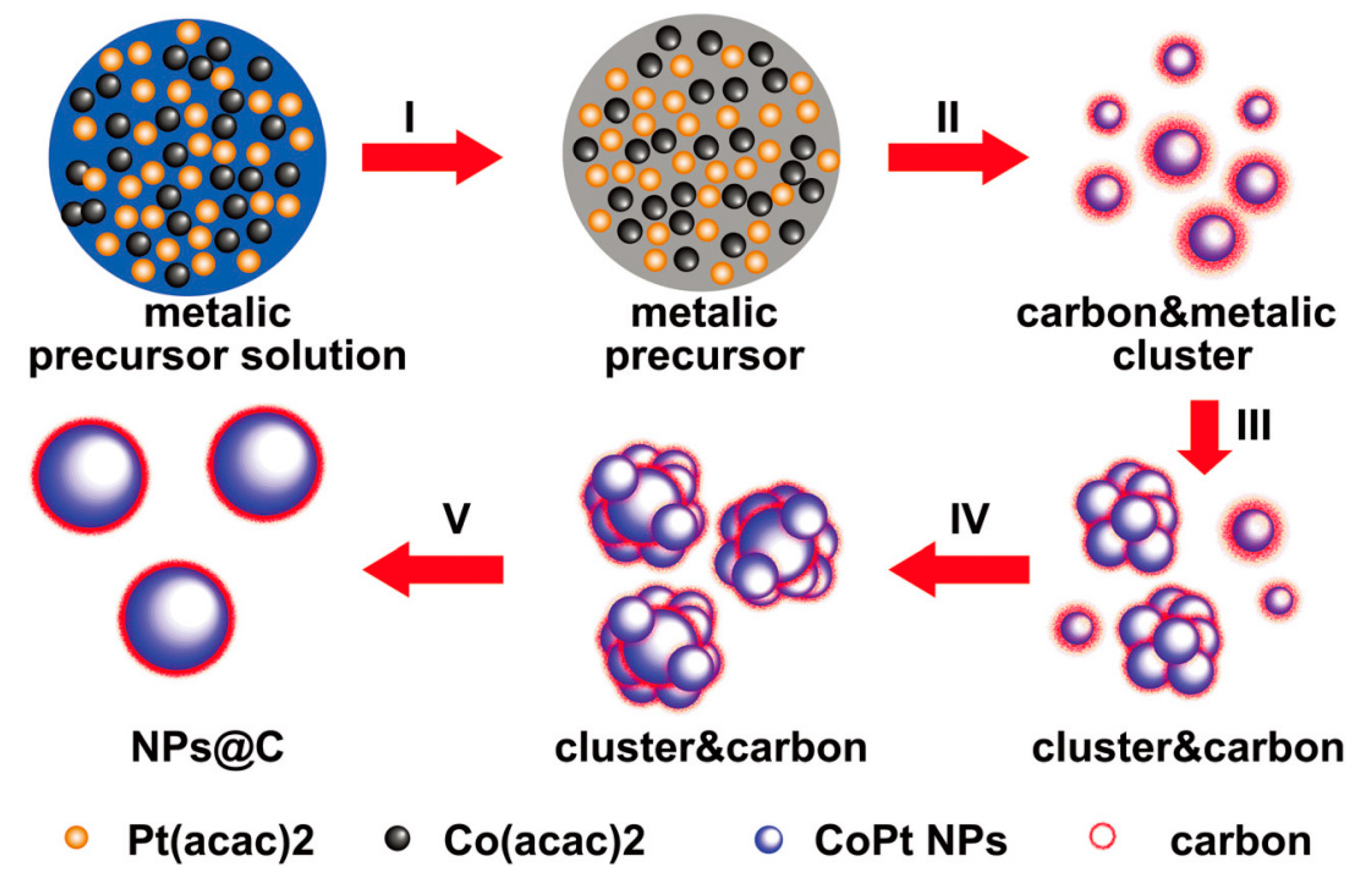
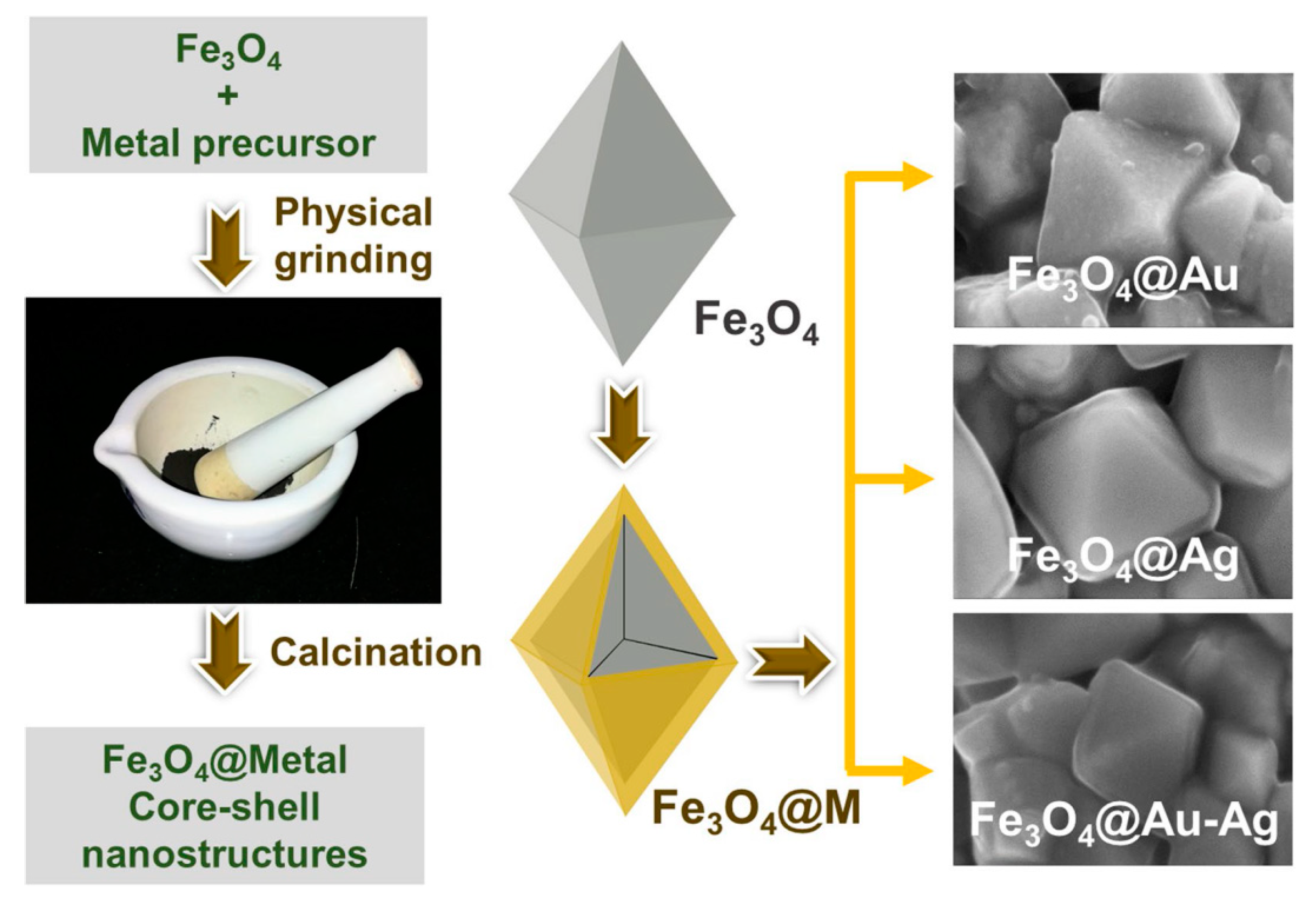
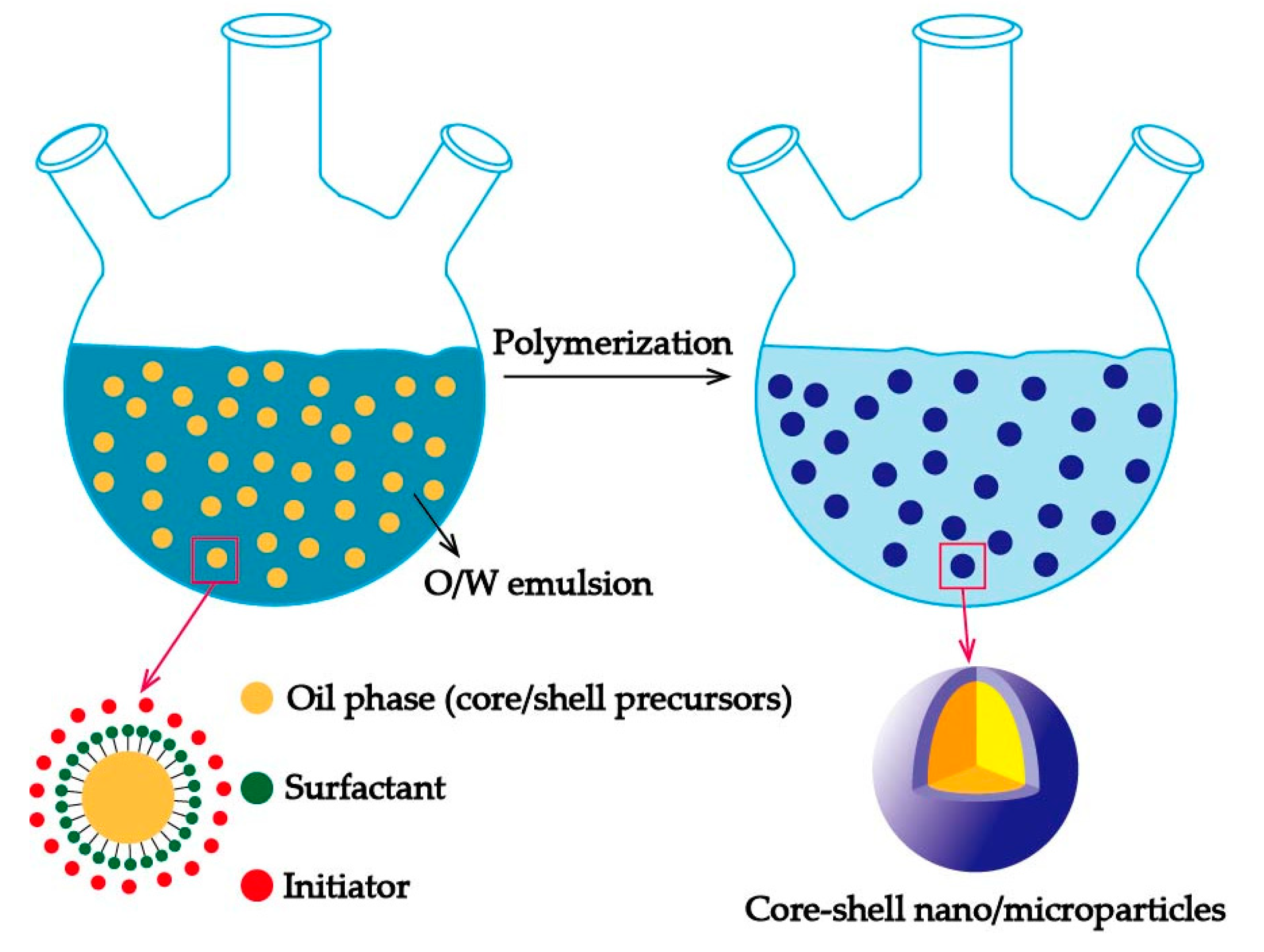
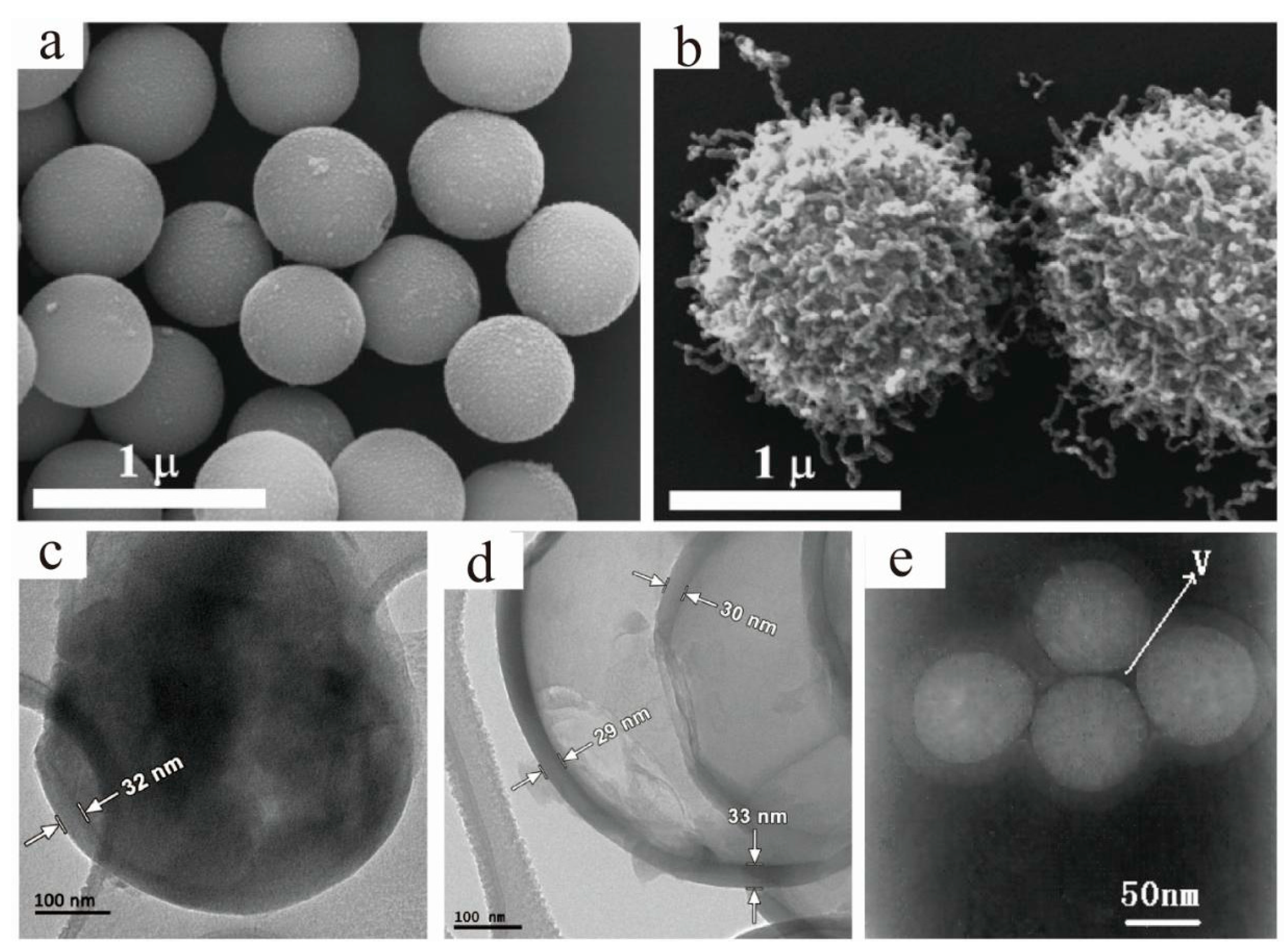
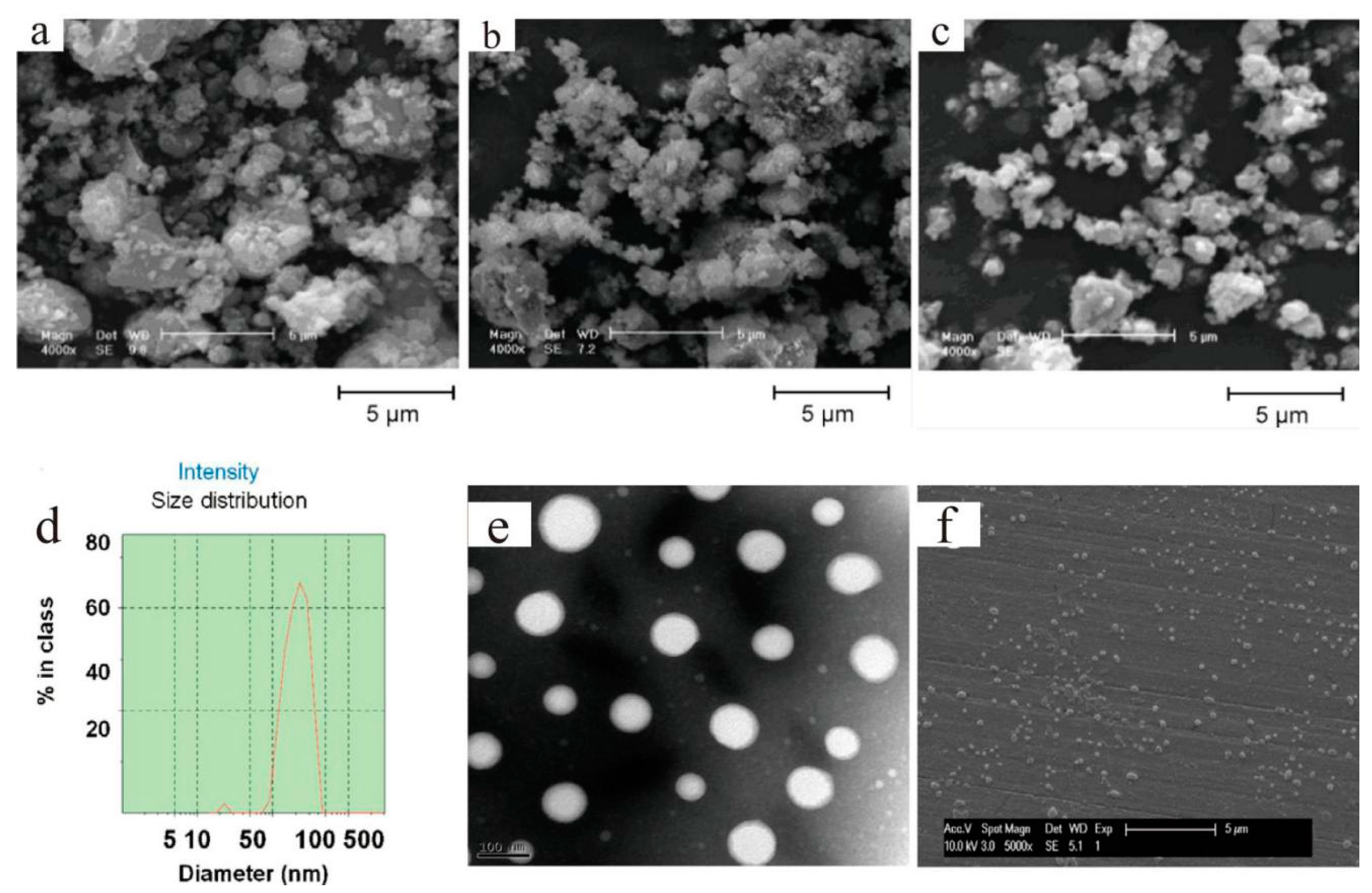
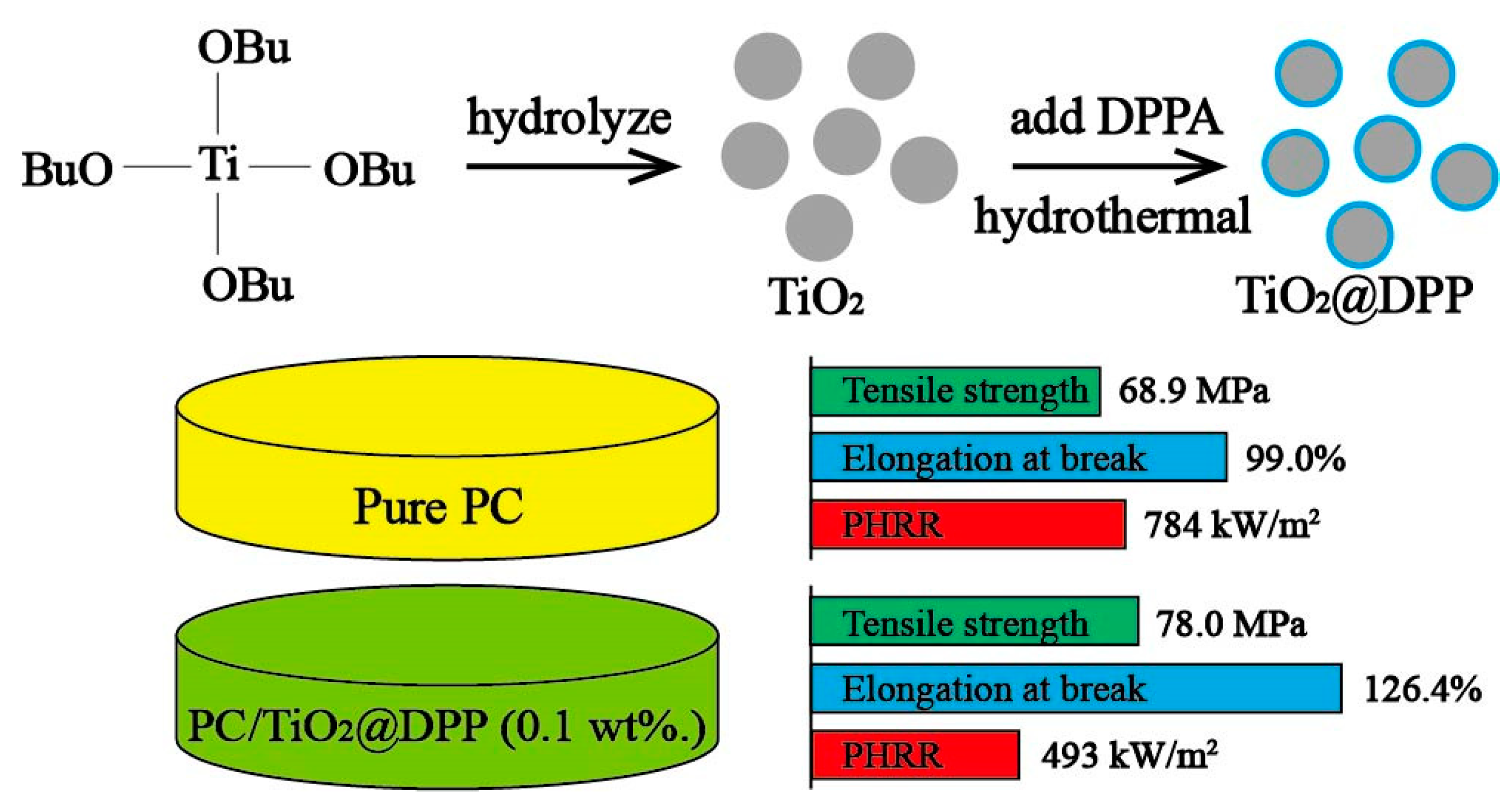

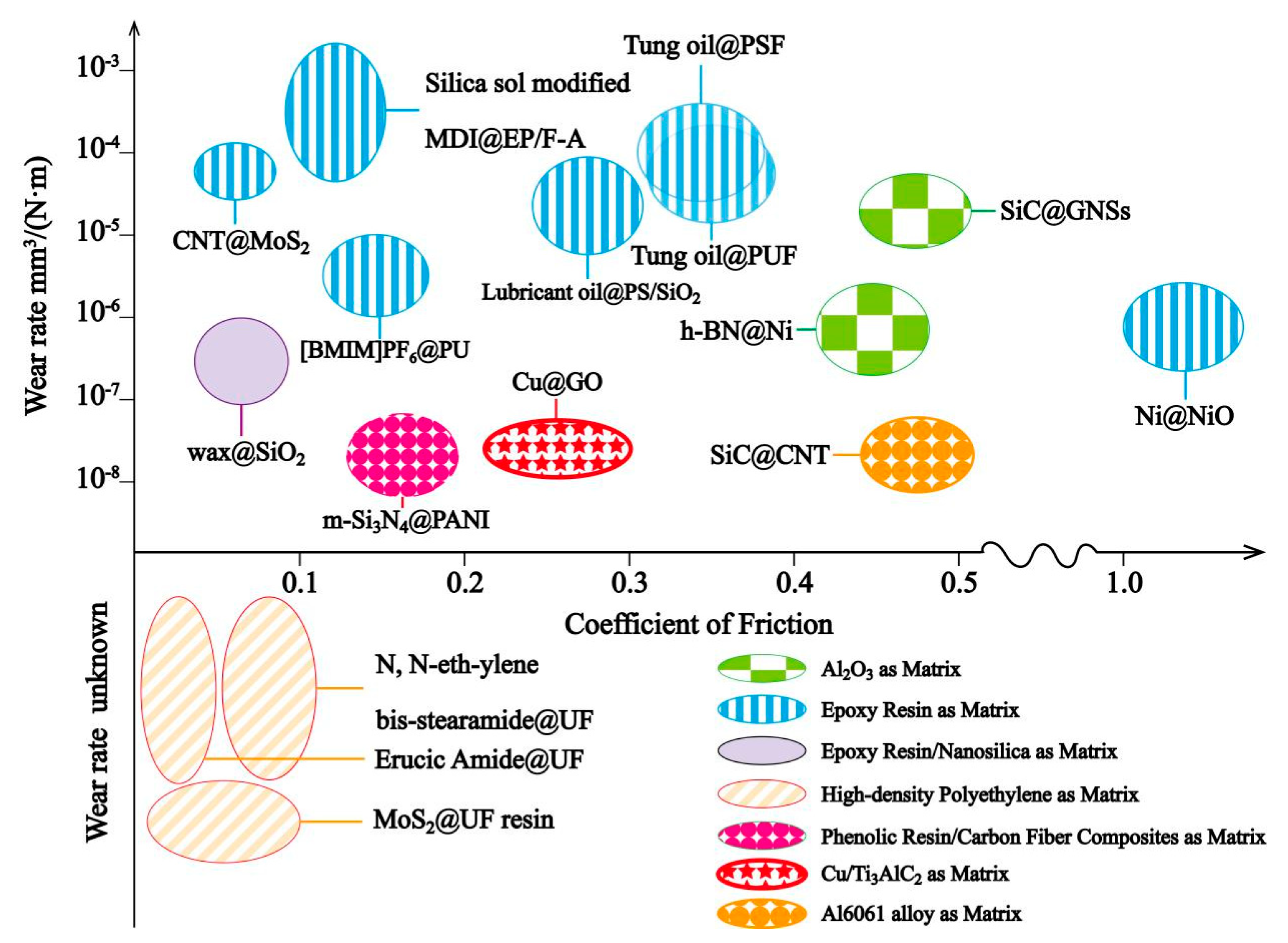

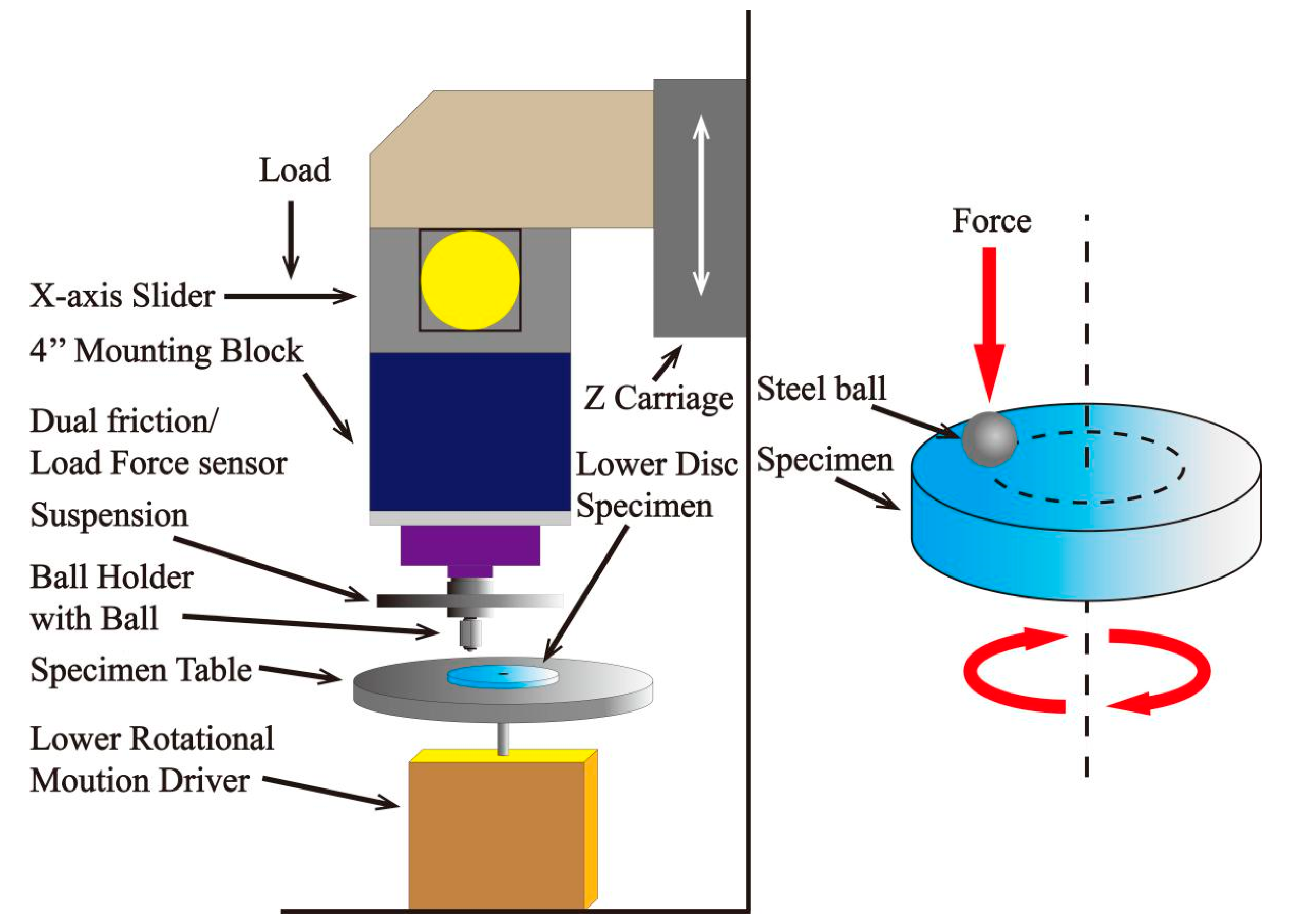

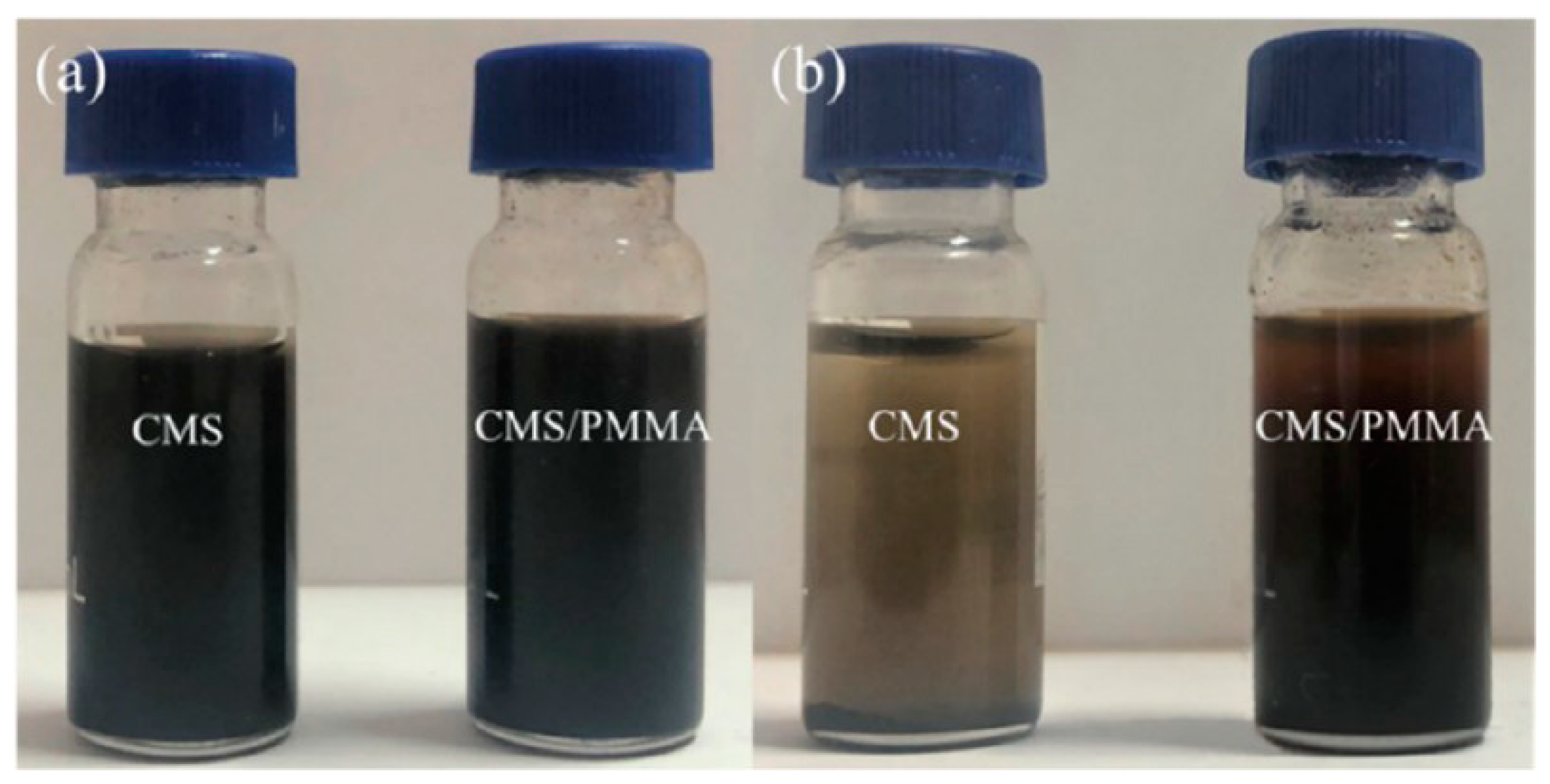
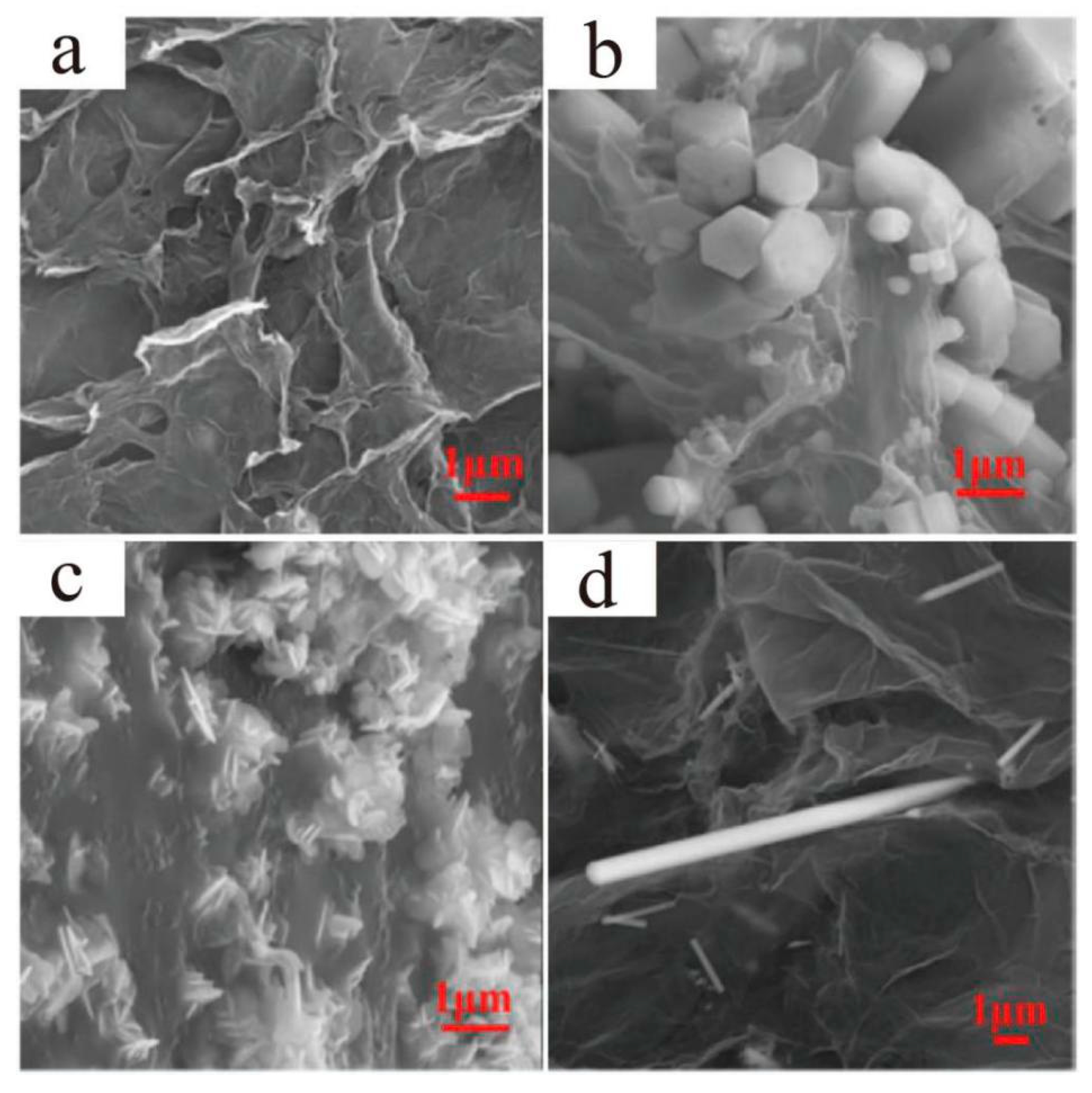
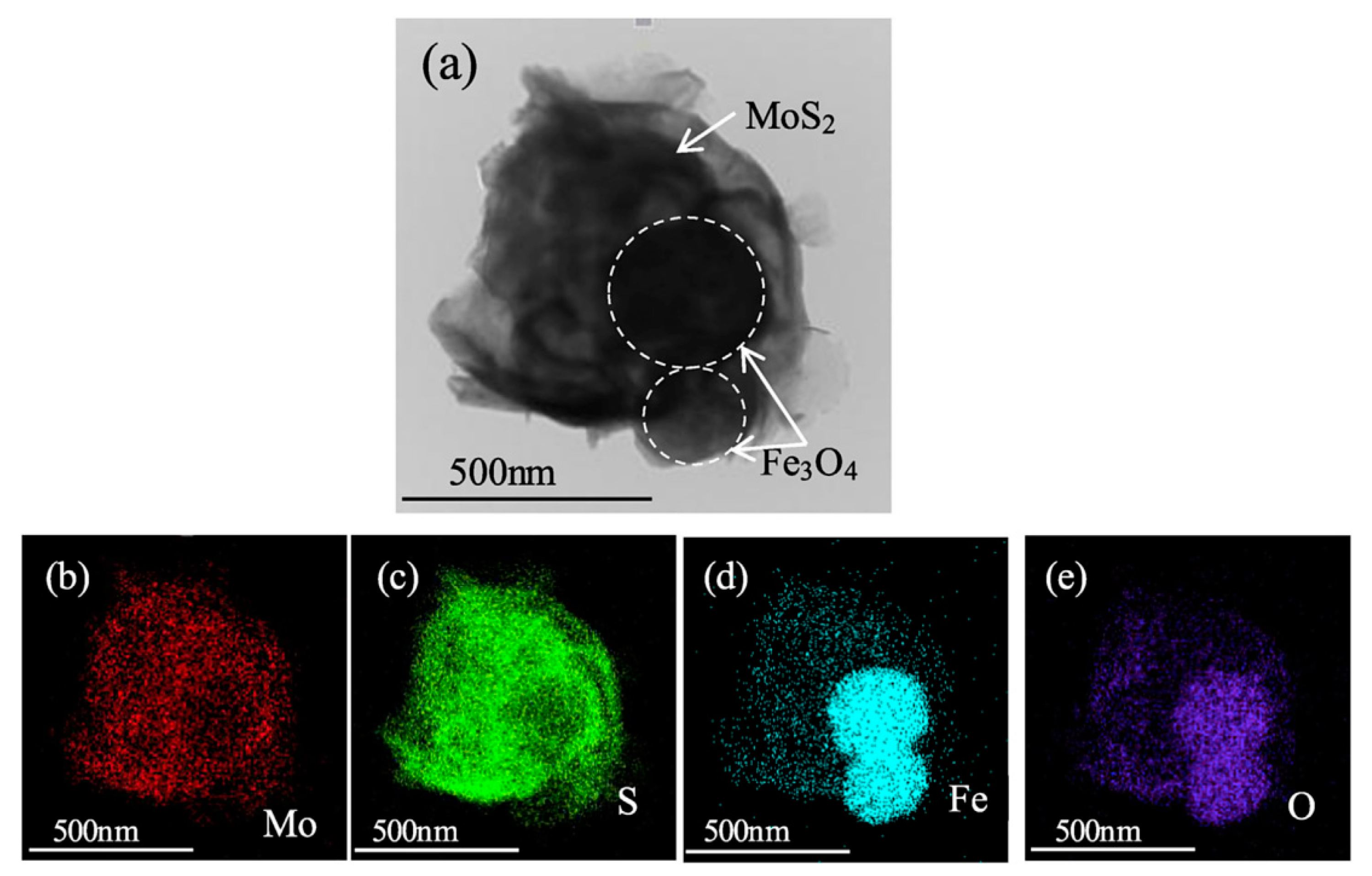

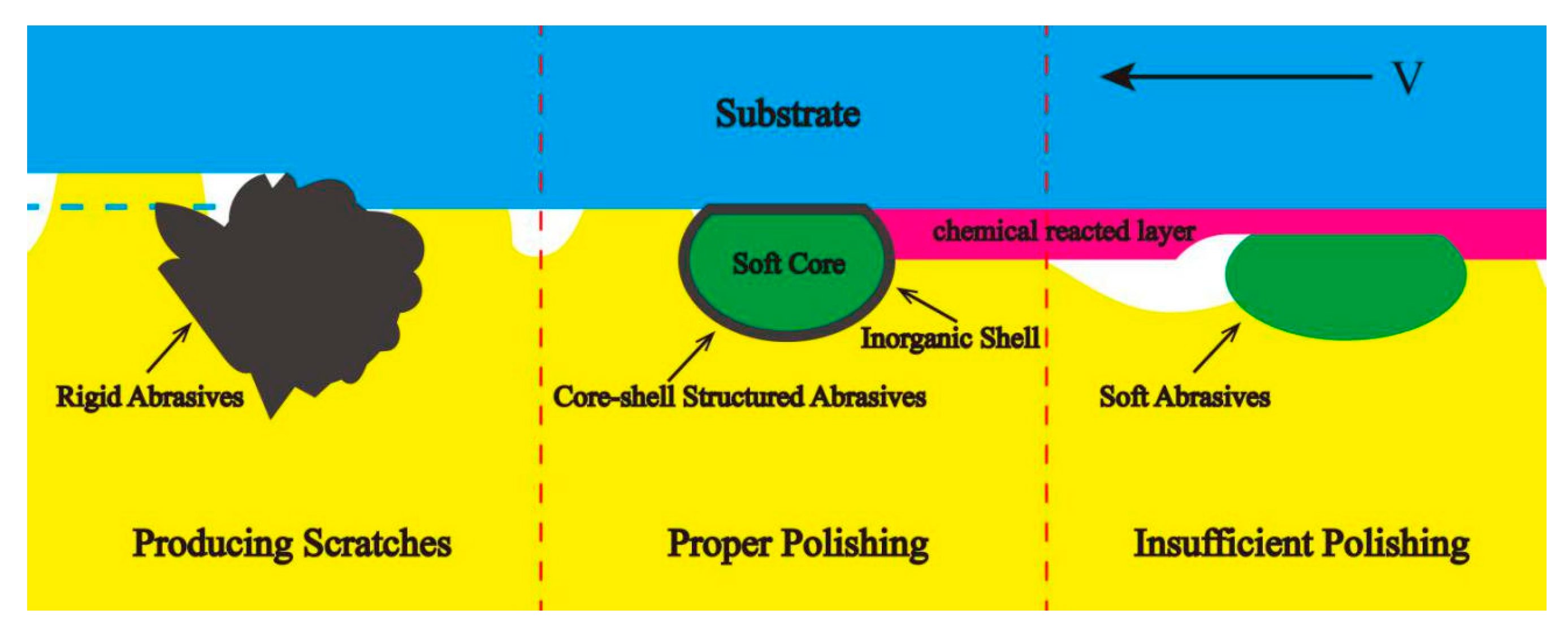
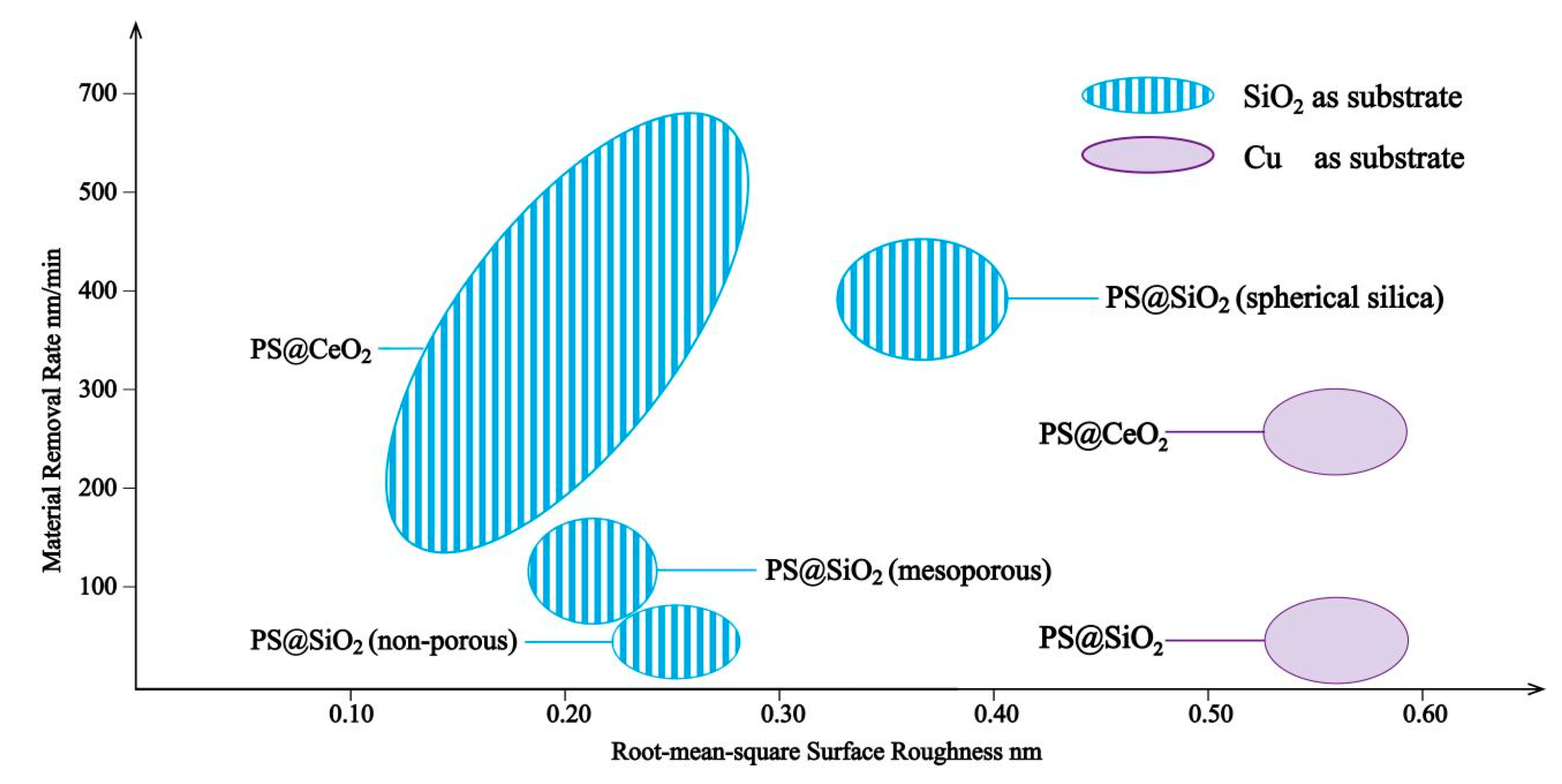
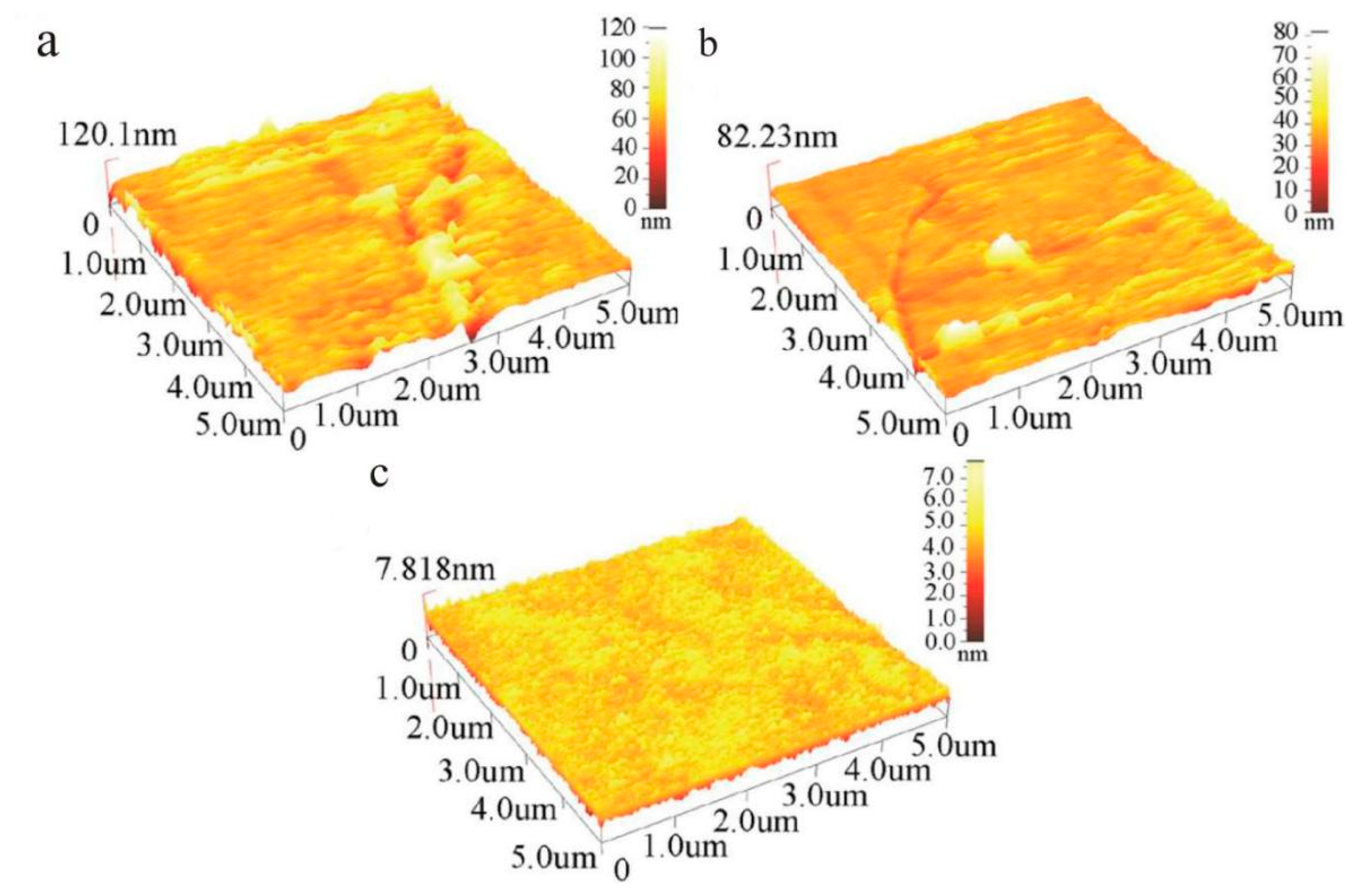
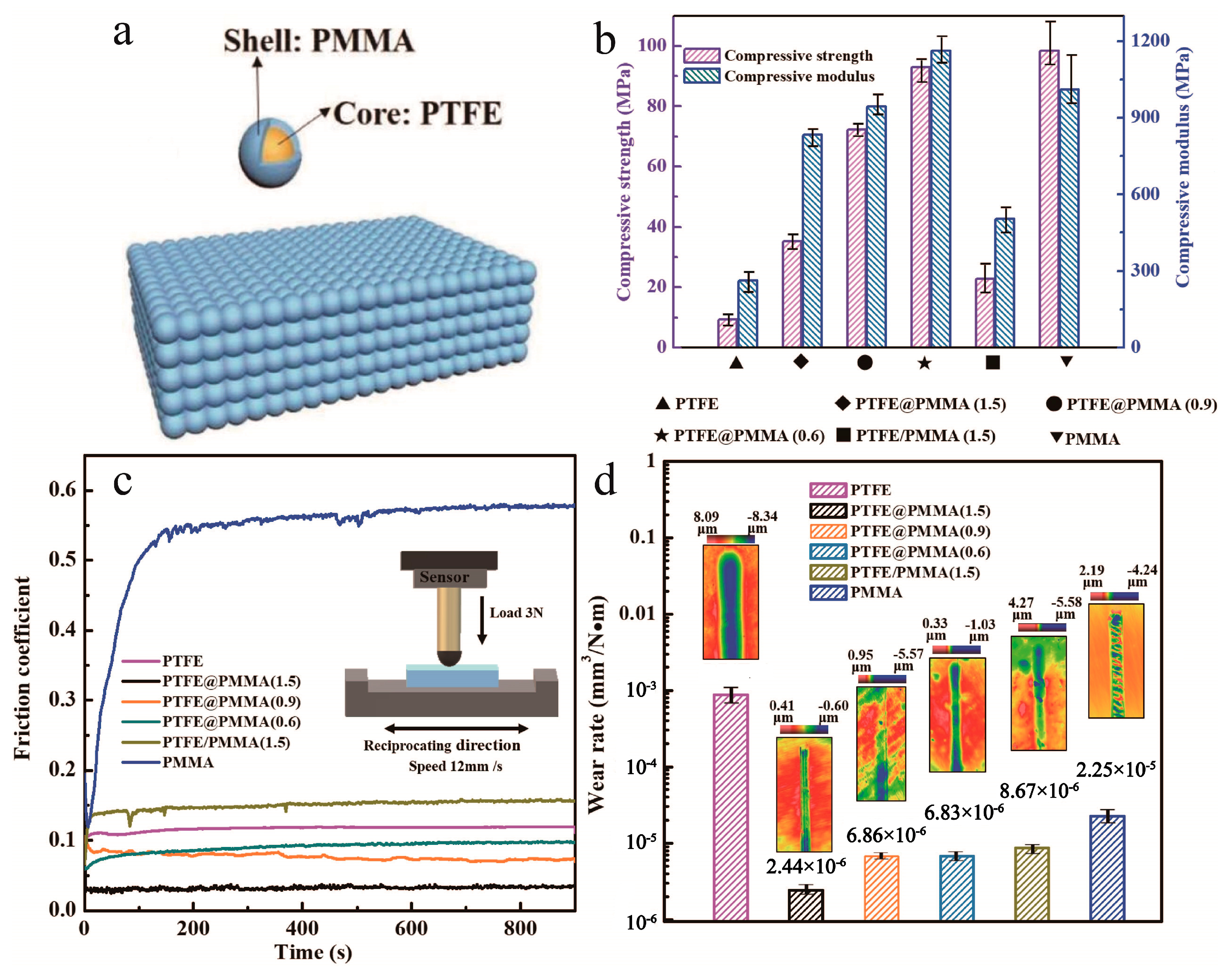
| Composites | Mechanical Properties (Compared with Pure Matrix) | Ref. | |
|---|---|---|---|
| Filler (Content) | Matrix | ||
| TiO2@DPP (0.10 wt %) | PC | Elongation at break: 126.4% (27.7 higher) Tensile strength: 78.0 MPa (14.7% higher) | [43] |
| SiC@SiO2-NH2 (10 wt %) | PI | Tensile strength: 185 MPa (77.1% higher) | [44] |
| SiO2@PMMA (5 wt %) | PVC | Elongation at break: 36.8% (105.6% higher) Tensile strength: 42.9 MPa (100.5% higher) | [45] |
| SiO2@PDMAEMA (2 wt %) | PAA | Compressive strength: 349.96 kPa (113.5% higher); | [46] |
| CaCO3@PMMA (0.75 wt %) | PP | Elongation at break: 675% (68.8% higher) | [47] |
| CaCO3@PMMA (1 wt %) | PP | Tensile strength: 55 MPa (71.9% higher) | [47] |
| CaCO3@PS (0.25 wt %) | PS | Elongation at break: around 50% (11% hgiher) | [48] |
| CaCO3@PS (1 wt %) | PS | Tensile strength: around 35 MPa (34% higher) | [48] |
| TiO2@PS (1 phr) | LLDPE/PLA | Elongation at break: 980% (95.2% higher) Tensile strength: 16.5 MPa (94.1% higher) | [49] |
| Starch@PMA (20 wt %) | PPC | Young’ s modulus: 529 MPa (50.4-fold higher) Tensile strength: 21.5 MPa (3.2-fold higher) Toughness: 82 J·m−3 (44% higher) | [50] |
| NR@PMMA-co-PMPS (5 wt %) | PMMA | Impact strength: 5.40 kJ/m2 (17.9% higher) Elongation at break: 6.25% (91% higher) Tensile strength: 54.59 MPa (2% higher) | [51] |
| BAR@MMA (3 wt %) | CDA | Impact strength: around 145 J/m (115% higher) | [52] |
| Poly(n-butyl acrylate)@PMMA (16.66 wt %) | PBT | Impact strength: 75.20 kJ/m2 (8.64-fold higher) | [53] |
| Ni@NiO (5 wt %) | EP | Hardness: 0.5 GPa (37.8% higher) Elastic modulus: 5.6 GPa (16.3% higher) Wear resistance: increased by 22.2-fold | [54] |
| Composites | Friction Condition | Friction Properties (Compared with Pure Matrix) | Ref. | |||
|---|---|---|---|---|---|---|
| Filler (Content) | Matrix | Load | Sliding Speed | COF | Wear Rate mm3/(N·m) | |
| LO@PU (20 wt %) | EP | 3 N | 0.05 m/s | 0.07 (90.65% lower) | [55] | |
| N, N-ethylene bis-stearamide@UF (10 wt %) | HDPE | 1 MPa | 50 rpm | 0.075 (25.4% lower) | · | [56] |
| Erucic Amide@UF (10 wt %) | HDPE | 1 Mpa | 150 rpm | 0.03 (66.7% lower) | · | [56] |
| Tung oil@PSF (10 wt %) | EP | 1.0 MPa | 0.51 m/s | 0.35 (23.9% lower) | 10−4 (66.1% lower) | [57] |
| Tung oil@UF (10 wt %) | EP | 1.0 MPa | 0.51 m/s | 0.38 (17.3% lower) | 8.26 × 10−5 (78.6% lower) | [58] |
| Lubricant oil@PS/SiO2 (10 wt %) | EP | 1.0 MPa | 0.51 m/s | 0.271 (52.5% lower) | 2.73 × 10−5 (92.9% lower) | [59] |
| [BMIM]PF6@PU (30 wt %) | EP | 1.0 MPa | 0.76 m/s | 0.151 (72.7% lower) | 4.81 × 10−6 (99.4% lower) | [60] |
| wax@SiO2 (10 wt %) | EP/SiO2 | 4 N | 0.12 m/s | 0.074 (87.7% lower) | 4.39 × 10−7 (three orders of magnitude lower) | [61] |
| MoS2@UF resin (10 wt %) | HDPE | 1.05 MPa | 150 rpm | 0.01 (89.5% lower) | · | [62] |
| CNF@MoS2 | EP | 4 N | 200 rpm | 0.075 (82.1% lower) | 8.6 × 10−5 (87.5% lower) | [63] |
| Ni@NiO (5 wt %) | EP | 1.0 MPa | 1.0 m/s | 1.05 (36.4% lower) | 10−6 | [54] |
| h-BN@Ni (5 vol %) | Al2O3/C | 20 N | 200 rpm | 0.45 (6.25% lower) | 10−6 (26.2% lower) | [64] |
| m-Si3N4@PANI (2.0 wt %) | Phenolic resin | · | · | 0.1681 (48.48% lower) | 1.13 × 10−8 (68.1% lower) | [65] |
| Cu@GO (0.8 wt %) | Cu/Ti3AlC2 | 4 N | 200 rpm | 0.2 (about 50% lower) | 2.0 × 10−8 | [66] |
| SiC@GNSs (5 vol %) | Al2O3 | 90 N | 0.1 m/s | 0.45 (29.4% lower) | 2.6 × 10−5 (90.1% lower) | [67] |
| SiC@CNT (5 vol %) | Al6061 alloy | 98.1 N | 200 rpm | 0.45 (31% lower) | 3.25 × 10−8 (45% lower) | [68] |
| Lubricant | Friction Condition | Friction Properties (Compared with Pure Liquid) | Ref. | |||
|---|---|---|---|---|---|---|
| Additive (Content) | Liquid | Load | Sliding Speed | COF | Wear Rate mm3/(N·m) | |
| C@PMMA (0.2 wt %) | Engine oil | 30 N | 0.08 m/s | 0.112 (21.7% lower) | 1.57 × 10−5 (41.42% lower) | [80] |
| TiO2@ODG (1 wt %) | PAO/HEO | 100 N | 0.05 m/s | 0.12 (18.5% lower) /0.10 (7.4% lower) | 3.44 × 10−6 (17.0% higher) /8.3 × 10−7(2.1% lower) | [81] |
| Cu-Ni@dodecanethiol (0.1 wt %) | LP | 196 N/392 N | 1450 rpm | 0.07 (61.1% lower) /0.07(39.1% lower) | · | [82] |
| Fe3O4@C (0.25 wt %) | Sunflower oil | 5 N | 300 rpm | 0.077 (15.4% lower) | · | [83] |
| Cu@SiO2 (0.4 wt %) | H2O | 4 N | 0.02 m/s | 0.17 (56.4% lower) | · | [84] |
| CNC (0.05 wt %) | Mineral oil | 261 MPa | 1.65 m/s | 0.01 (25.9% lower) | · | [85] |
| ZnO@graphene (0.5~1.0 wt %) | Ester base oil | 392 N | 1200 rpm | 0.075 (25% lower) | · | [86] |
| Fe3O4@MoS2 (1 wt %) | PAO4 | 20 N | 0.05 m/s | 0.08 (56.5% lower) | · | [87] |
| Fe3O4@MoS2 (0.08 wt %) | LP | · | · | 0.066 (30.3% lower) | · | [88] |
| PSPMA-g-HSNPs (0.5 wt %) | H2O | 1.66 GPa | 0.05 m/s | 0.173 (49.9% lower) | 8.02 × 10−4 (52.7% lower) | [89] |
| IL-g-SiO2 (2 wt %) | H2O | 90 Mpa | 0.15 m/s | 0.10 (41.2% lower) | 2.7 × 10−6 (28.8% lower) | [90] |
| SiO2@PMMA (0.3 wt %) | [BMIM][NTf2] | 2 N | 0.05 m/s | 0.01 (85.7% lower) | · | [91] |
| Core–Shell Particles | Substrate | RMS Surface Roughness (nm) | MRR (nm/min) | Ref. |
|---|---|---|---|---|
| PS@SiO2 (spherical silica) | SiO2 | 0.37 ± 0.03 (63% lower than PS; 22.92% lower than SiO2) | 387 ± 44 | [94] |
| PS@SiO2 | Cu | 0.56 (86.89% lower than SiO2) | 45 | [16] |
| PS@SiO2 (mesoporous) | SiO2 | 0.22 ± 0.02 (42.11% lower than SiO2) | 123 ± 15 (68% higher than SiO2) | [95] |
| PS@SiO2 (non-porous) | SiO2 | 0.25 ± 0.03 (34.21% lower than SiO2) | 47 ± 13 (36% lower than SiO2) | [95] |
| PS@CeO2 | SiO2 | 0.15 ± 0.02 (40% lower than CeO2) | 189 ± 19 (49% higher than CeO2) | [96] |
| PS@CeO2 | SiO2 | 0.239 (60.6% lower than CeO2) | 517.6 (440.3% higher than CeO2) | [97] |
| PS@CeO2 | Cu | 0.56 (70.37% lower than CeO2) | 254 | [98] |
Publisher’s Note: MDPI stays neutral with regard to jurisdictional claims in published maps and institutional affiliations. |
© 2020 by the authors. Licensee MDPI, Basel, Switzerland. This article is an open access article distributed under the terms and conditions of the Creative Commons Attribution (CC BY) license (http://creativecommons.org/licenses/by/4.0/).
Share and Cite
Chen, H.; Zhang, L.; Li, M.; Xie, G. Synthesis of Core–Shell Micro/Nanoparticles and Their Tribological Application: A Review. Materials 2020, 13, 4590. https://doi.org/10.3390/ma13204590
Chen H, Zhang L, Li M, Xie G. Synthesis of Core–Shell Micro/Nanoparticles and Their Tribological Application: A Review. Materials. 2020; 13(20):4590. https://doi.org/10.3390/ma13204590
Chicago/Turabian StyleChen, Hao, Lin Zhang, Mengyu Li, and Guoxin Xie. 2020. "Synthesis of Core–Shell Micro/Nanoparticles and Their Tribological Application: A Review" Materials 13, no. 20: 4590. https://doi.org/10.3390/ma13204590
APA StyleChen, H., Zhang, L., Li, M., & Xie, G. (2020). Synthesis of Core–Shell Micro/Nanoparticles and Their Tribological Application: A Review. Materials, 13(20), 4590. https://doi.org/10.3390/ma13204590





